Page 283 of 1771
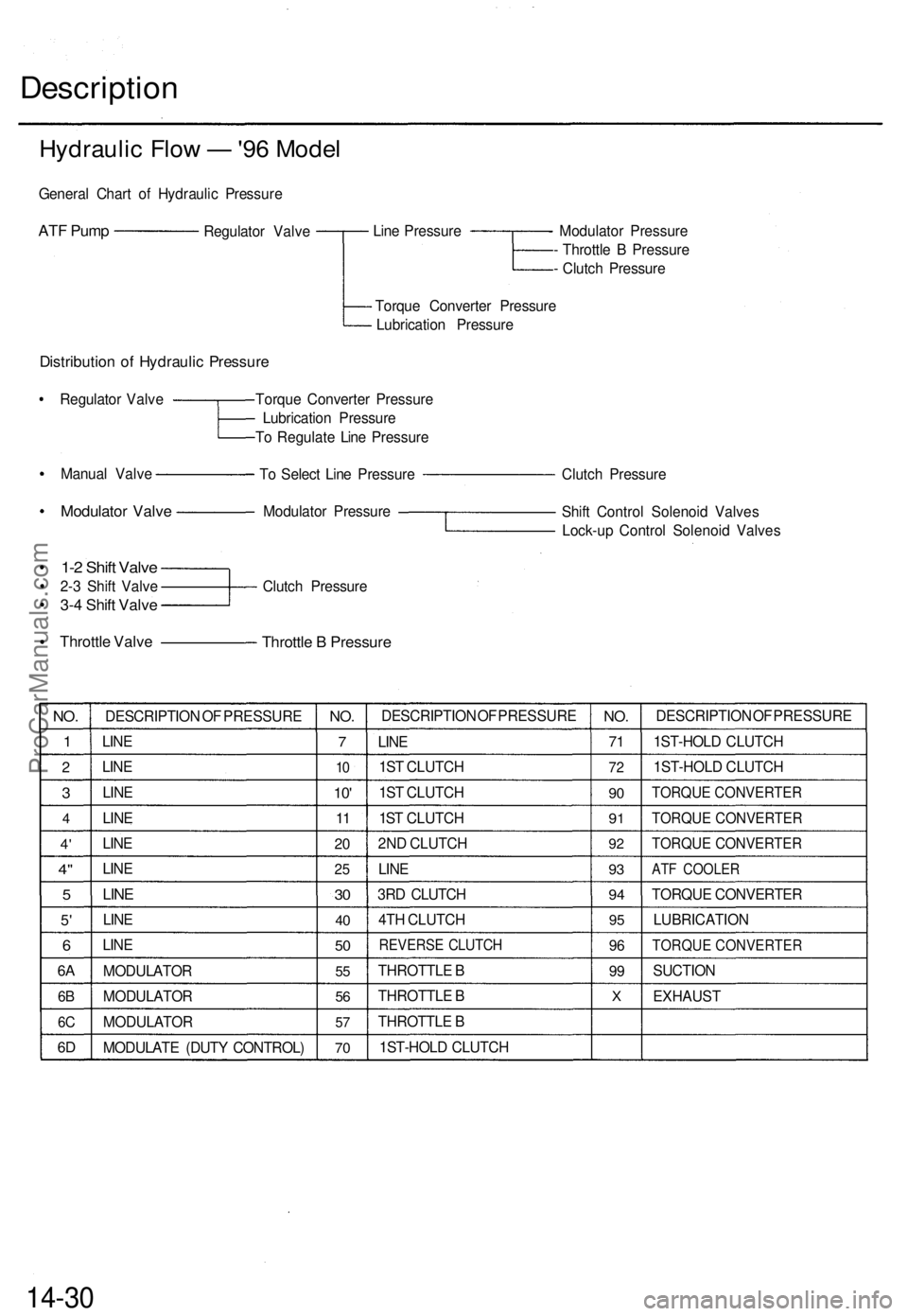
Description
Line Pressur e - Modulato r Pressur e
- Throttl e B Pressur e
- Clutc h Pressur e
Distributio n o f Hydrauli c Pressur e
Regulato r Valv e Torque Converte r Pressur e
Lubricatio n Pressur e
T o Regulat e Lin e Pressur e
Manua l Valv e
Modulato r Valv e
To Selec t Lin e Pressur e
Modulato r Pressur e Clutc
h Pressur e
Shif t Contro l Solenoi d Valve s
Lock-u p Contro l Solenoi d Valve s
1-2 Shif t Valv e
2-3 Shif t Valv e
3-4 Shif t Valv e
Throttl e Valv e
Clutc h Pressur e
Throttle B Pressur e
NO.
1
2
3
4
4'
4"
5
5 '
6
6A
6 B
6C
6D
DESCRIPTIO N O F PRESSUR E
LIN E
LIN E
LIN E
LIN E
LIN E
LIN E
LINE
LIN E
LIN E
MODULATO R
MODULATO R
MODULATO R
MODULAT E (DUT Y CONTROL )
NO.
7
10
10 '
11
2 0
2 5
30
4 0
5 0
5 5
56
57
7 0
DESCRIPTIO N O F PRESSUR E
LIN E
1S T CLUTC H
1S T CLUTC H
1S T CLUTC H
2N D CLUTC H
LIN E
3R D CLUTC H
4T H CLUTC H
REVERS E CLUTC H
THROTTL E B
THROTTL E B
THROTTL E B
1ST-HOL D CLUTC H
NO.
71
7 2
90
9 1
9 2
93
9 4
9 5
96
99
X
DESCRIPTIO N O F PRESSUR E
1ST-HOL D CLUTC H
1ST-HOL D CLUTC H
TORQU E CONVERTE R
TORQUE CONVERTE R
TORQUE CONVERTE R
ATF COOLE R
TORQUE CONVERTE R
LUBRICATIO N
TORQUE CONVERTE R
SUCTION
EXHAUS T
14-30
Hydrauli c Flo w — '96 Mode l
Genera l Char t o f Hydrauli c Pressur e
ATF Pum pRegulato r Valv e
Torque Converte r Pressur e
Lubricatio n Pressur e
ProCarManuals.com
Page 284 of 1771
Position
(cont'd)
As the engine turns, the ATF pump also starts to operate. Automatic transmission fluid (ATF) is drawn from (99) and dis-
charged into (1). Then, ATF flowing from the ATF pump becomes the line pressure (1). The line pressure (1) is regulated
by the regulator valve. The torque converter inlet pressure (92) enters (94) of the torque converter through the lock-up
shift valve and discharges into (90).
The torque converter check valve prevents the torque converter pressure from rising.
Under this condition, the hydraulic pressure is not applied to the clutches as the manual valve stops line pressure (1).
NOTE: When used, "left" or "right" indicates direction on the hydraulic circuit.ProCarManuals.com
Page 287 of 1771
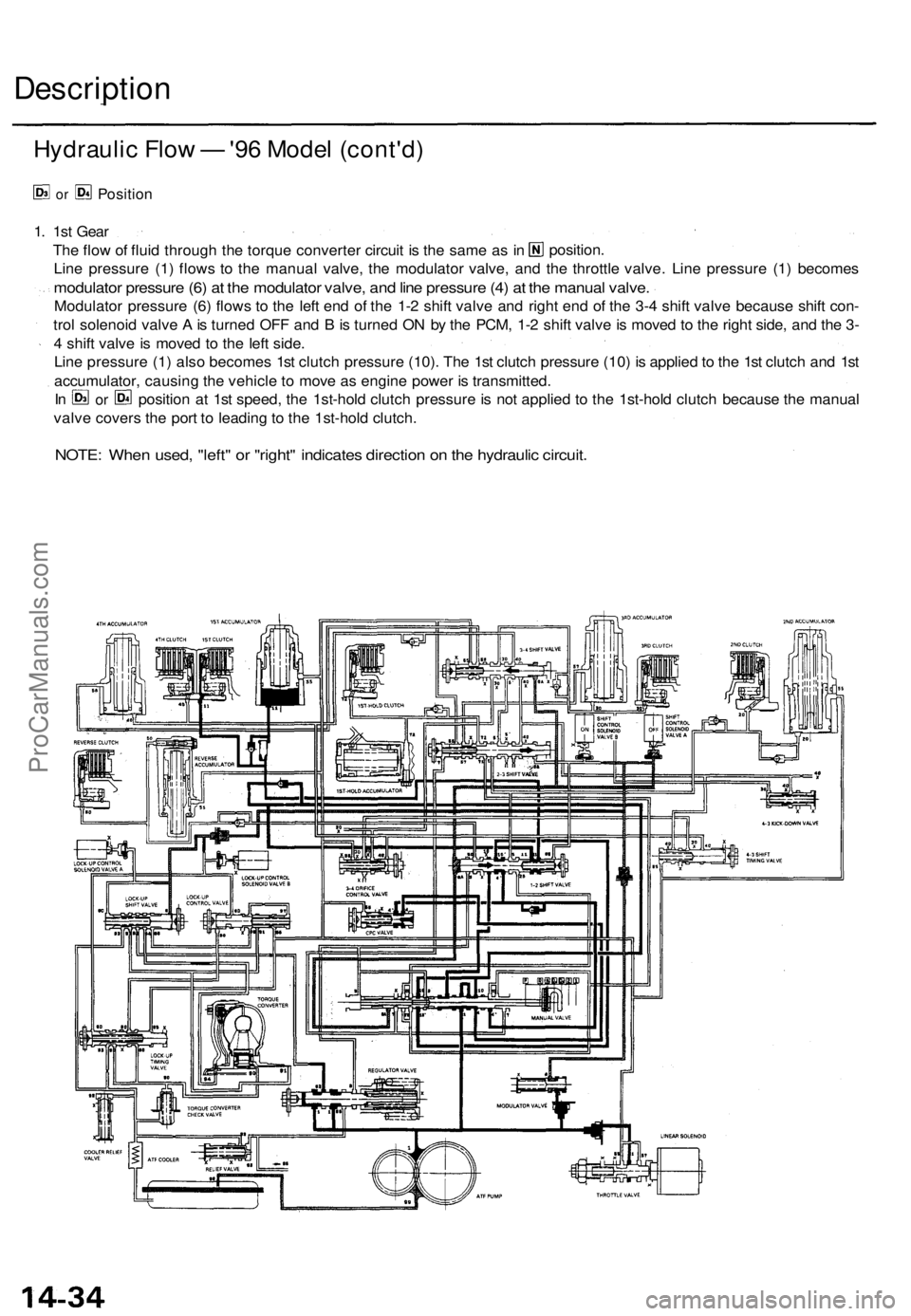
Description
Hydraulic Flow — '96 Model (cont'd)
or
Position
NOTE: When used, "left" or "right" indicates direction on the hydraulic circuit.
1. 1st Gear
Line pressure (1) flows to the manual valve, the modulator valve, and the throttle valve. Line pressure (1) becomes
modulator pressure (6) at the modulator valve, and line pressure (4) at the manual valve.
Modulator pressure (6) flows to the left end of the 1-2 shift valve and right end of the 3-4 shift valve because shift con-
trol solenoid valve A is turned OFF and B is turned ON by the PCM, 1-2 shift valve is moved to the right side, and the 3-
4 shift valve is moved to the left side.
Line pressure (1) also becomes 1st clutch pressure (10). The 1st clutch pressure (10) is applied to the 1st clutch and 1st
accumulator, causing the vehicle to move as engine power is transmitted.
valve covers the port to leading to the 1st-hold clutch.
position.
The flow of fluid through the torque converter circuit is the same as in
In
or
position at 1st speed, the 1st-hold clutch pressure is not applied to the 1st-hold clutch because the manualProCarManuals.com
Page 291 of 1771
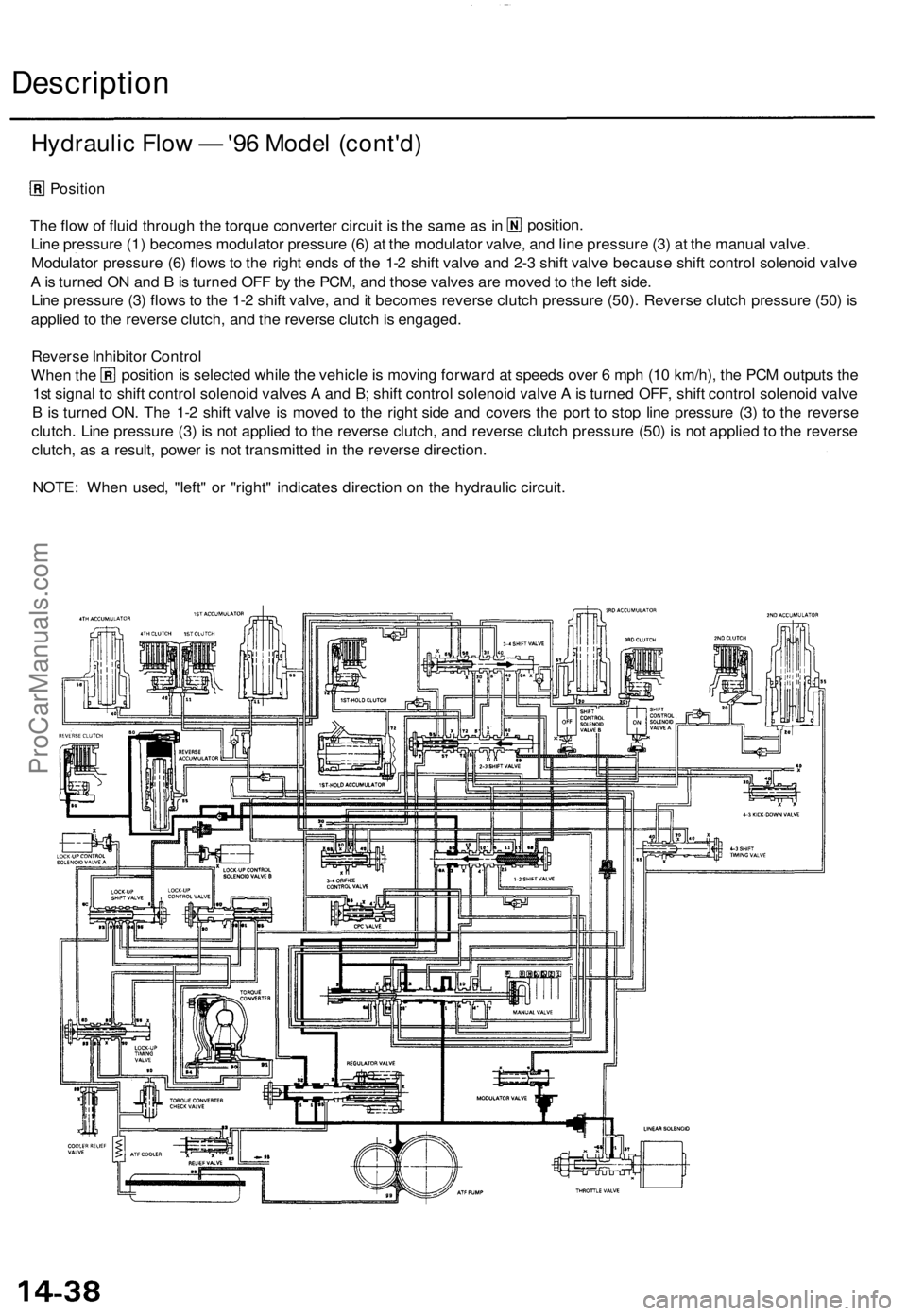
Description
Hydraulic Flow — '96 Model (cont'd)
Position
The flow of fluid through the torque converter circuit is the same as in
Line pressure (1) becomes modulator pressure (6) at the modulator valve, and line pressure (3) at the manual valve.
Modulator pressure (6) flows to the right ends of the 1-2 shift valve and 2-3 shift valve because shift control solenoid valve
A is turned ON and B is turned OFF by the PCM, and those valves are moved to the left side.
Line pressure (3) flows to the 1-2 shift valve, and it becomes reverse clutch pressure (50). Reverse clutch pressure (50) is
applied to the reverse clutch, and the reverse clutch is engaged.
position.
NOTE: When used, "left" or "right" indicates direction on the hydraulic circuit.
Reverse Inhibitor Control
When the
1st signal to shift control solenoid valves A and B; shift control solenoid valve A is turned OFF, shift control solenoid valve
B is turned ON. The 1-2 shift valve is moved to the right side and covers the port to stop line pressure (3) to the reverse
clutch. Line pressure (3) is not applied to the reverse clutch, and reverse clutch pressure (50) is not applied to the reverse
clutch, as a result, power is not transmitted in the reverse direction.
position is selected while the vehicle is moving forward at speeds over 6 mph (10 km/h), the PCM outputs theProCarManuals.com
Page 292 of 1771
Position
The flow of fluid through the torque converter circuit is the same as in
Line pressure (1) is intercepted by the manual valve. Hydraulic pressure is not supplied to the clutches, and power is not
transmitted.
position.ProCarManuals.com
Page 293 of 1771
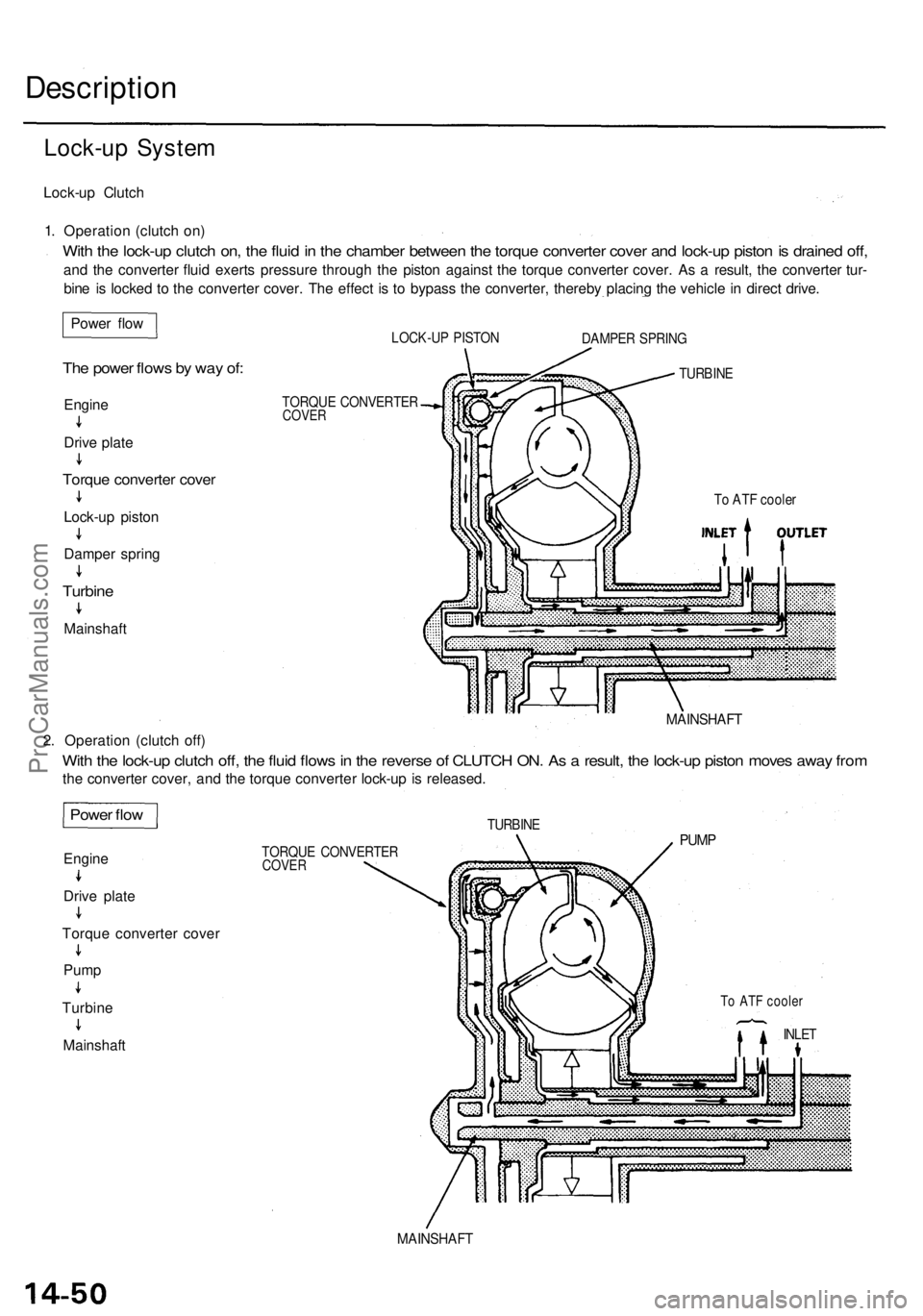
Description
Lock-up System
Lock-up Clutch
1. Operation (clutch on)
With the lock-up clutch on, the fluid in the chamber between the torque converter cover and lock-up piston is drained off,
and the converter fluid exerts pressure through the piston against the torque converter cover. As a result, the converter tur-
bine is locked to the converter cover. The effect is to bypass the converter, thereby placing the vehicle in direct drive.
LOCK-UP PISTON
TORQUE CONVERTER
COVER
TURBINE
DAMPER SPRING
To ATF cooler
TURBINE
PUMP
To ATF cooler
INLET
TORQUE CONVERTER
COVER
2. Operation (clutch off)
With the lock-up clutch off, the fluid flows in the reverse of CLUTCH ON. As a result, the lock-up piston moves away from
the converter cover, and the torque converter lock-up is released.
MAINSHAFT
Power flow
The power flows by way of:
Engine
Drive plate
Torque converter cover
Lock-up piston
Damper spring
Turbine
Mainshaft
Power flow
Engine
Drive plate
Torque converter cover
Pump
Turbine
Mainshaft
MAINSHAFTProCarManuals.com
Page 295 of 1771
Description
No Lock-up
The pressurized fluid regulated by the modulator works on both ends of the lock-up shift valve and on the left side of the
lock-up control valve. Under this condition, the pressures working on both ends of the lock-up shift valve are equal, and
the shift valve is moved to the right side by the tension of the valve spring alone. The fluid from the pump will flow
through the left side of the lock-up clutch to the torque converter; that is, the lock-up clutch is in OFF condition.
NOTE:
When used, "left" or "right" indicates direction on the hydraulic circuit.
The hydraulic circuit shows '97 - '98 models; '96 model is similar.
Lock-up System (cont'd)ProCarManuals.com
Page 296 of 1771
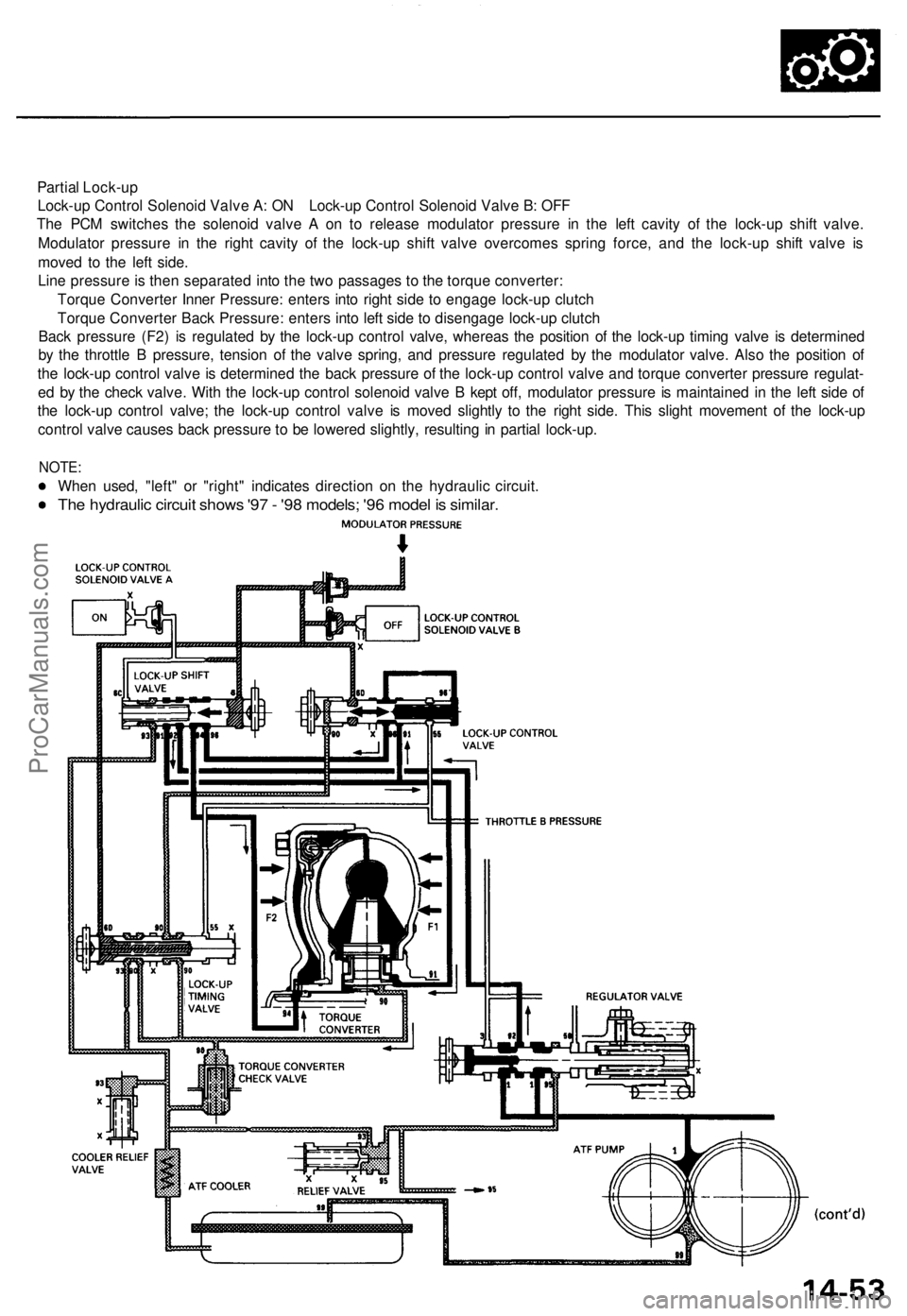
Partial Lock-up
Lock-up Control Solenoid Valve A: ON Lock-up Control Solenoid Valve B: OFF
The PCM switches the solenoid valve A on to release modulator pressure in the left cavity of the lock-up shift valve.
Modulator pressure in the right cavity of the lock-up shift valve overcomes spring force, and the lock-up shift valve is
moved to the left side.
Line pressure is then separated into the two passages to the torque converter:
Torque Converter Inner Pressure: enters into right side to engage lock-up clutch
Torque Converter Back Pressure: enters into left side to disengage lock-up clutch
Back pressure (F2) is regulated by the lock-up control valve, whereas the position of the lock-up timing valve is determined
by the throttle B pressure, tension of the valve spring, and pressure regulated by the modulator valve. Also the position of
the lock-up control valve is determined the back pressure of the lock-up control valve and torque converter pressure regulat-
ed by the check valve. With the lock-up control solenoid valve B kept off, modulator pressure is maintained in the left side of
the lock-up control valve; the lock-up control valve is moved slightly to the right side. This slight movement of the lock-up
control valve causes back pressure to be lowered slightly, resulting in partial lock-up.
NOTE:
When used, "left" or "right" indicates direction on the hydraulic circuit.
The hydraulic circuit shows '97 - '98 models; '96 model is similar.ProCarManuals.com